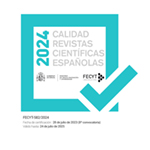Los leones de El Macalón (Nerpio, Albacete). Monumento, ideología y control territorial en la formación del mundo ibérico
Abstract
En este trabajo se propone que las esculturas de El Macalón corresponden a leones y no a esfinges, teniendo en cuenta sus características morfológicas. El número de 5/6 ejemplares idénticos permite proponer la existencia de un único monumento ligado a una necrópolis, localizada en el acceso al poblado de El Macalón. Los indicios cronológicos señalan una cronología antigua, entre la segunda mitad s. VII y VI a.C. La iconografía del león tiene una fuerte implicación religiosa y política, y se relaciona con una apropiación del territorio y de las vías de comunicación por parte de comunidades que muestran importantes vínculos con productos de origen oriental. En el s. VI a.C. el yacimiento muestra signos de violencia coincidiendo con la crisis que afecta al mundo fenicio en toda la zona del sureste.
Downloads
##submission.format##
Licenza
La revista Complutum, para fomentar el intercambio global del conocimiento, facilita el acceso sin restricciones a sus contenidos desde el momento de su publicación en la presente edición electrónica, y por eso es una revista de acceso abierto. Los originales publicados en esta revista son propiedad de la Universidad Complutense de Madrid y es obligatorio citar su procedencia en cualquier reproducción total o parcial. Todos los contenidos se distribuyen bajo una licencia de uso y distribución Creative Commons Reconocimiento 4.0 (CC BY 4.0). Esta circunstancia ha de hacerse constar expresamente de esta forma cuando sea necesario. Puede consultar la versión informativa y el texto legal de la licencia.










